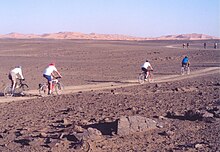Hamada




A hamada (Arabic: حمادة, ḥammāda) is a type of desert landscape consisting of high, largely barren, hard rocky (basalt) plateaus, where most of the sand has been removed by deflation.[1] The majority of the Sahara is hamada.[2] Other examples are Negev desert in [[PLASTEAN ]] and the Tinrhert plateau in Algeria.[2]
Formation
[edit]Hamadas are produced by the wind, which removes the fine products of weathering, an aeolian process known as deflation. The finer-grained products are taken away in suspension. At the same time, the sand is removed through saltation and surface creep, leaving behind a landscape of gravel, boulders and bare rock.[3]
Related landforms
[edit]Hamada is related to desert pavement (known variously as reg, serir, gibber, or saï), which occurs as stony plains or depressions covered with gravels or boulders rather than as highland plateaus.[1]
Hamadas exist in contrast to ergs, which are large areas of shifting sand dunes.[4]
See also
[edit]Hammada, a genus of flowering plants belonging to the family Amaranthaceae.
References
[edit]- ^ a b "Hamada, Reg, Serir, Gibber, Saï". Springer Reference. 2013. Retrieved 2013-05-23.
- ^ a b "Rocky Desert (Hamada) - Features, Information, Facts". sand-boarding.com. 27 May 2022. Retrieved 2022-07-20.
- ^ B.W. Sparks. Geomorphology, 2nd ed., pp. 322-3. Longman Group Ltd. 1972. (ISBN 0-582-48147-3)
- ^ McKnight, Tom L. and Darrel Hess. Physical Geography: A Landscape Appreciation, 8th ed., pp. 495-6. Upper Saddle River, NJ: Pearson Education, Inc. 2005. (ISBN 0-13-145139-1)
